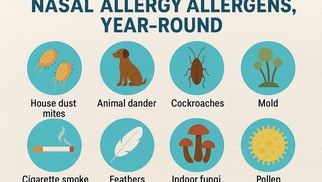Year Round Allergic Rhinitis Causes Symptoms and Treatment


Allergic rhinitis, commonly referred to as hay fever, is one of the most prevalent chronic allergic conditions worldwide. While seasonal allergic rhinitis dominates public awareness, many individuals live with year-round symptoms, known as perennial allergic rhinitis. This condition involves a persistent inflammatory response in the nasal mucosa, largely driven by continuous allergen exposure.
What Is Allergic Rhinitis That Won’t Go Away?
Unlike transient upper respiratory infections, allergic rhinitis does not resolve on its own. It is the result of a malfunction in the immune system. When allergens such as dust mites, mold, pet dander, or cockroach droppings are inhaled, the immune system in predisposed individuals misidentifies these harmless particles as threats. This initiates the release of immunoglobulin E (IgE), which binds to mast cells, leading to the release of histamines and other pro-inflammatory substances. The result is chronic sneezing, nasal congestion, watery rhinorrhea, and ocular symptoms.
In clinical practice, it is not uncommon for patients to present with years of symptoms misattributed to chronic colds or sinus infections. The failure to correctly diagnose allergic rhinitis can delay effective therapy, prolonging suffering and increasing healthcare costs.
Can Allergic Rhinitis Be Year-Round?
Year-round allergic rhinitis occurs when allergens are constantly present. Households with pets, poor ventilation, or high indoor humidity are particularly risky. Even in workplaces and schools, environmental allergens can persist. Unlike seasonal forms of allergic rhinitis, which fluctuate with pollen seasons, perennial allergic rhinitis rarely offers symptomatic reprieve.
This constant immune activation not only disrupts daily life but can also predispose individuals to more serious complications. Recurrent sinus infections, otitis media, nasal polyps, and worsening asthma symptoms are often noted in severe, untreated cases.
Diagnosis and Evaluation
Accurate diagnosis involves a detailed patient history, often revealing symptom patterns that correlate with particular environments. Physical examination may reveal swollen, pale nasal turbinates and clear rhinorrhea. Allergy testing, either through skin prick testing or serum-specific IgE measurements, is pivotal in identifying causative allergens.
Advanced diagnostics such as nasal cytology, rhinomanometry, and nasal provocation tests are increasingly used in research and difficult cases to gain deeper insights into the patient’s condition.
How Do You Treat Seasonal Allergic Rhinitis?
The cornerstone of allergic rhinitis treatment remains allergen avoidance. Environmental control measures include encasing mattresses and pillows in allergen-proof covers, removing carpets, minimizing upholstered furniture, and controlling household humidity. HEPA filters and vacuum cleaners equipped with HEPA technology are essential tools.
Pharmacological management includes intranasal corticosteroids as the first-line therapy. These reduce inflammation at the site of allergen exposure. Oral antihistamines help to relieve sneezing and itching, while leukotriene receptor antagonists serve as useful adjuncts in patients with both asthma and rhinitis.
For patients with severe symptoms or those who do not respond to standard therapies, allergen immunotherapy remains the only disease-modifying intervention. Administered either by subcutaneous injections or sublingual tablets, immunotherapy gradually induces immune tolerance to allergens.
What Is a Year-Long Rhinitis?
Year-long rhinitis can severely impact patient well-being. Sleep disturbances from chronic nasal obstruction contribute to fatigue, poor academic or work performance, and mood disorders. For children, perennial allergic rhinitis can impair learning and social interactions due to chronic nasal congestion and poor sleep.
Multiple studies have confirmed the association between perennial allergic rhinitis and asthma. The concept of the "united airway" model has led to better understanding and management, recognizing the nose and lungs as part of the same respiratory continuum.
What Is the Best Climate for Allergic Rhinitis?
Climate plays a key role, but individual variability is high. While dry desert climates can reduce pollen exposure, they may also increase dust levels, another common allergen. Mountainous regions with lower pollen counts may benefit some patients. Coastal areas are often moderate but can foster mold growth due to humidity.
Some patients with severe disease consider relocating temporarily to assess symptom improvement, although this is not routinely advised without specialist consultation.
The Role of Flovent in the Treatment of the Condition
Flovent (fluticasone) is primarily indicated for asthma but is chemically identical to the fluticasone used in Flovent nasal spray, a gold standard in the treatment of allergic rhinitis. Flovent works by suppressing local immune activity, reducing nasal swelling and mucus production.
In patients with combined allergic asthma and rhinitis, Flovent for airway control and Flonase for nasal symptoms may be prescribed concurrently. When used under medical supervision, corticosteroids like these are safe and highly effective.
It’s critical for patients to follow dosing instructions closely to avoid local side effects like nasal dryness, epistaxis (nosebleeds), and, rarely, mucosal ulceration.
Emerging Therapies and Lifestyle Modifications
Recent advances have introduced biologic agents targeting IgE (omalizumab) and cytokines like IL-4 and IL-13 (dupilumab) for severe allergic conditions. Though currently approved primarily for asthma and atopic dermatitis, clinical trials are exploring their role in perennial allergic rhinitis.
Lifestyle modifications also play a major role. Stress reduction, regular physical activity, good sleep hygiene, and avoidance of tobacco smoke and strong odors can lessen symptom severity. Nutritional support, including diets rich in antioxidants and omega-3 fatty acids, may offer anti-inflammatory benefits.
Patient Case Studies and Real-World Experience
Case studies show that early diagnosis and proactive management significantly improve outcomes. One illustrative example involves a young adult male with a 10-year history of "chronic colds." After proper evaluation, perennial allergic rhinitis was diagnosed, and with tailored allergen avoidance strategies and Flonase therapy, the patient achieved near-total symptom resolution and reported dramatic improvements in quality of life.
Another case involved a child with poorly controlled asthma and constant nasal congestion. Comprehensive environmental controls and allergen immunotherapy allowed for substantial reduction in both asthma exacerbations and rhinitis symptoms.
Conclusion
Year-round allergic rhinitis is not just a nasal condition; it is a systemic inflammatory disorder with far-reaching effects on overall health and quality of life. It requires a multidisciplinary approach that includes patient education, environmental control, pharmacotherapy, and in some cases, immunotherapy or biologics.
The combination of scientific advances and individualized care models offers hope for people who previously struggled with refractory disease. With products like Flonase and potentially emerging biologics, patients now have access to a range of safe and effective options that can dramatically reduce symptoms and restore well-being.
Medically Reviewed by Dr. Rabeea Aboufakher, MD
(Updated at May 13 / 2025)

